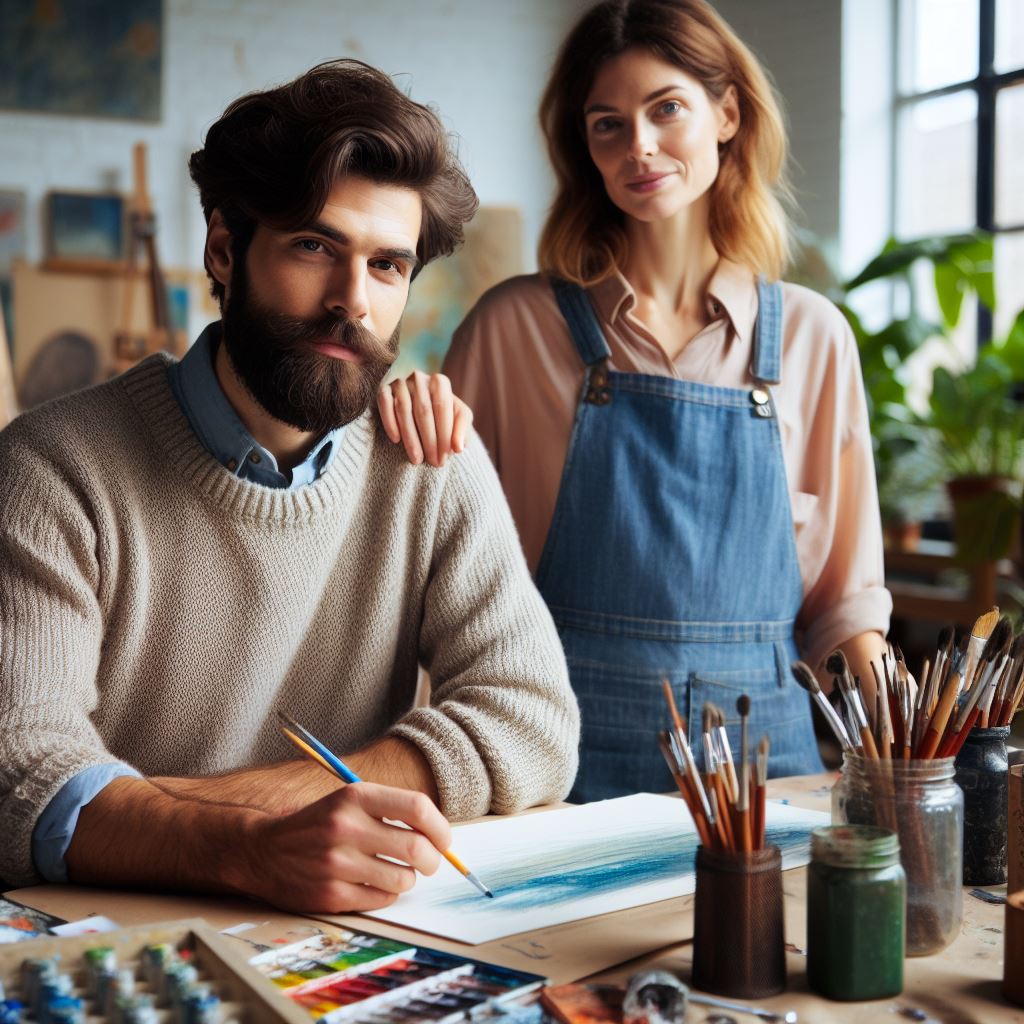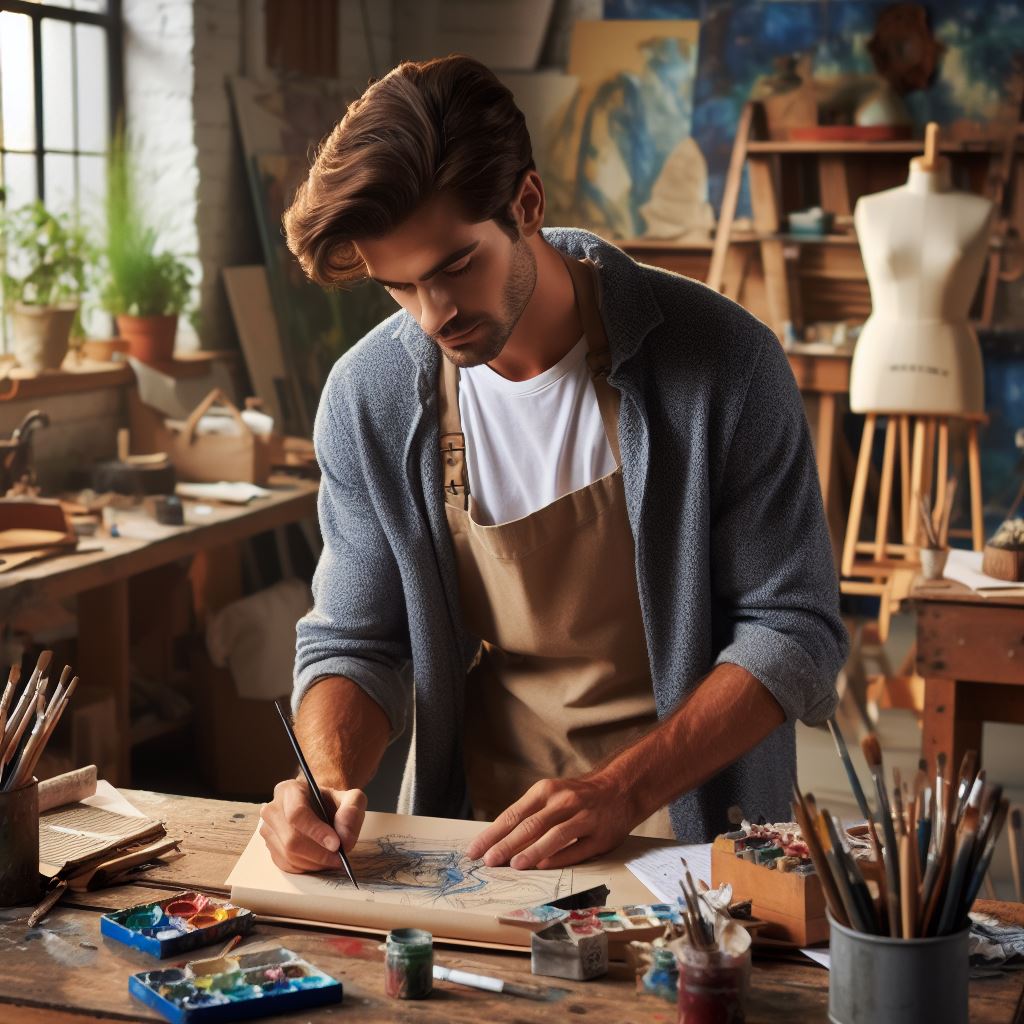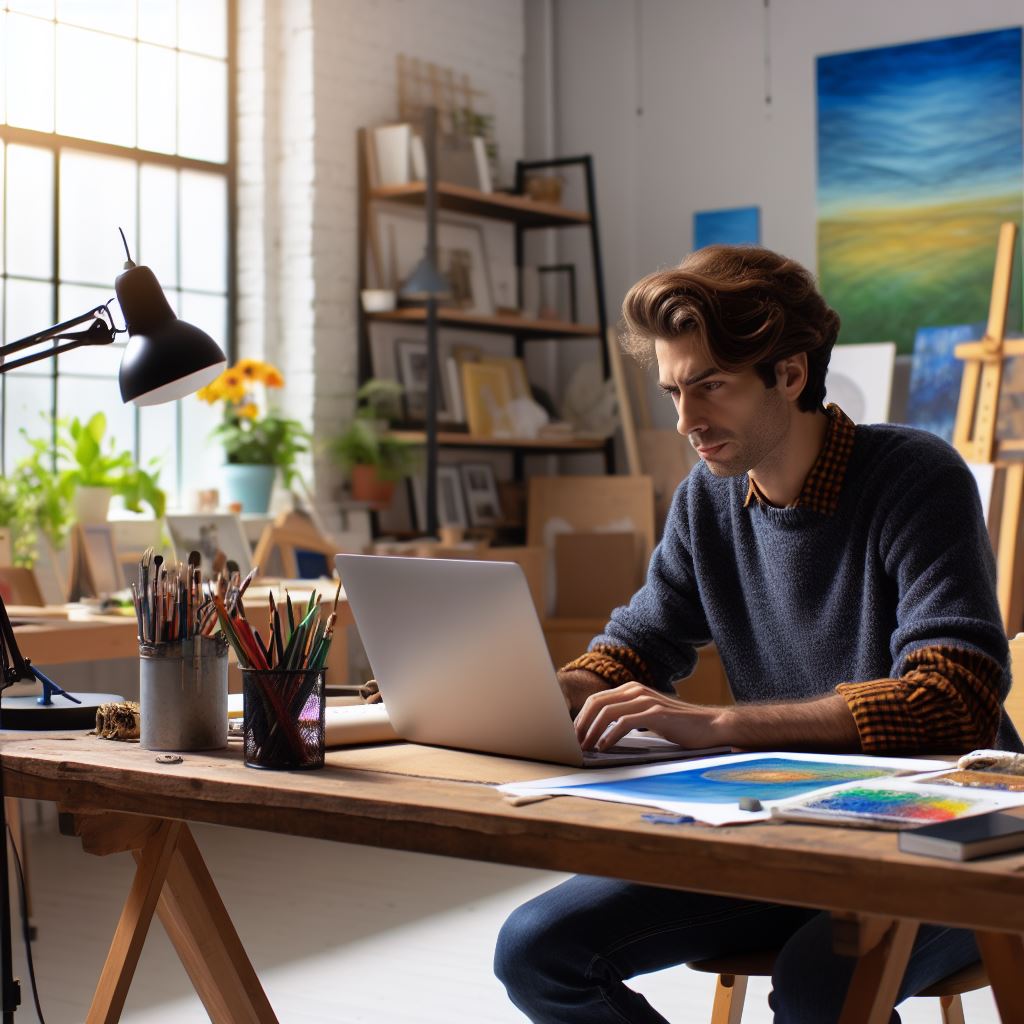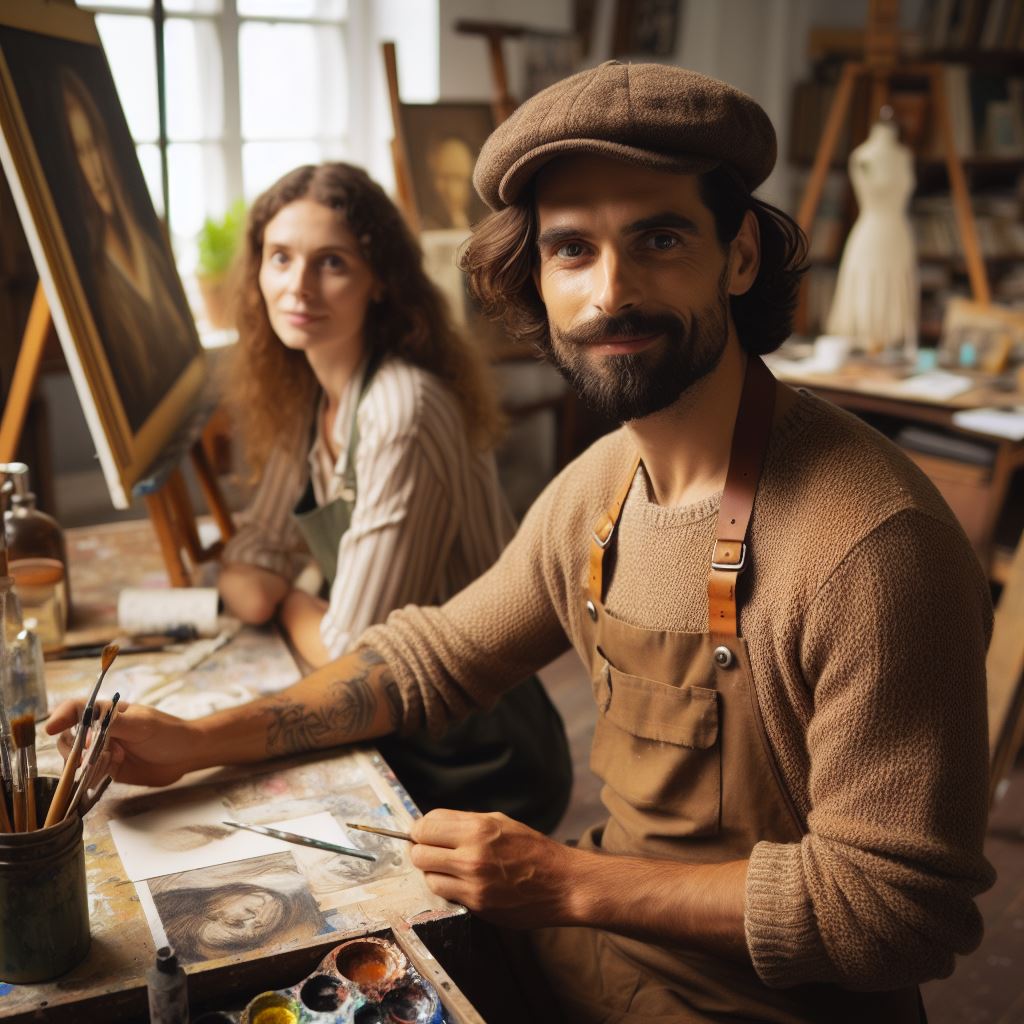Introduction
Welcome to a captivating exploration into the daily lives of artists in the UK. This blog post is not just a mere glimpse but a detailed dive into the authentic experiences that shape the artistic journey.
As we embark on this insightful journey, the purpose is clear – to bring to light the real, unfiltered narratives of UK artists.
Overview of What to Expect
Throughout this post, we will delve into the intricacies of an artist’s daily routine, shedding light on the challenges, triumphs, and creative processes that define their existence.
From the solitude of the studio to the hustle of navigating the art industry, each aspect contributes to the rich tapestry of an artist’s life.
It’s more than just a narrative; it’s an exploration of the diverse paths artists tread and the unique stories they have to tell.
The Importance of Real Experiences
Why focus on real experiences? Because these narratives offer a nuanced understanding of the artistic landscape.
It’s about going beyond the finished artworks and understanding the heartbeat of creativity—the struggles, the moments of inspiration, and the dedication that propels artists forward.
By sharing these real experiences, we aim to foster a deeper appreciation for the artistry that enriches our culture.
Join us in unraveling the stories behind the canvases, sculptures, and performances that contribute to the vibrant artistic tapestry of the UK.
This isn’t just an invitation to peek into the lives of artists; it’s a celebration of the passion that fuels their creative spirit.
As we navigate the following sections, each filled with the voices of UK artists, we hope you gain a profound understanding of the intricate journey that unfolds behind the scenes.
Overview of the UK art industry
The UK boasts a thriving art scene with numerous galleries, museums, and exhibitions.
Artists in the UK work across a diverse range of art forms and mediums, including painting, sculpture, photography, and digital art.
This diversity contributes to a rich and dynamic cultural landscape that attracts art enthusiasts from around the world.
Artists in the UK have access to various opportunities, such as grants, residencies, and commissions, which help them gain recognition and support their artistic endeavors.
However, along with these opportunities, artists also face challenges in the UK art industry.
Competition for recognition and exposure can be fierce, and many artists struggle to make a living solely from their artwork.
Some artists may need to balance their artistic pursuits with other jobs to sustain themselves financially.
The high cost of living and studio rents in major cities like London can also pose challenges for artists.
Despite these challenges, the UK art industry provides a vibrant ecosystem for artists to grow and thrive.
Collaborations between artists, galleries, and institutions foster creativity and push the boundaries of artistic expression.
Artists in the UK benefit from a supportive community that encourages experimentation and innovation.
Personalized UK Career Consulting
Receive tailored career guidance designed just for you. Get actionable steps and expert support to boost your career in 1-3 days. Take control of your career now.
Get StartedThe success stories of renowned British artists inspire aspiring artists and contribute to the industry’s reputation.
The UK art industry is also driven by the public’s enthusiasm for art, with a significant number of art fairs, festivals, and open studios taking place across the country.
These events provide artists with platforms to showcase their work, engage with audiences, and make valuable connections.
Furthermore, the UK government recognizes the value of the arts and invests in cultural initiatives, museums, and galleries.
Public support plays a crucial role in nurturing the UK art industry and ensuring its continued growth and vitality.
A day in the life of a UK artist
Today, let’s dive into the fascinating world of a UK artist and explore the daily experiences they encounter.
To give you a concrete example, we’ll spotlight the talented Lisa James, a renowned oil painter from London.
Introducing Lisa James
Lisa James is a highly regarded artist in the UK art scene, known for her captivating oil paintings that showcase the beauty of nature and landscapes.
With her incredible talent and unique style, Lisa has gained recognition both locally and internationally.
A Typical Routine
A typical day in the life of Lisa James starts early in the morning.
She believes that inspiration flows best during the morning hours, when her mind is fresh and free from distractions.
After a wholesome breakfast, she heads straight to her art studio.
Once in her studio, Lisa spends a few minutes organizing her easels, brushes, and paints.
She takes a moment to meditate and visualize her creative goals for the day, ensuring a focused mindset.
With her canvas set up and paints readily available, Lisa begins her artistic journey.
She immerses herself in her work, channeling her emotions and creative energy onto the canvas.
Hours seem to fly by as she gets lost in the world she’s creating.
However, being an artist isn’t just about painting.
Lisa also dedicates time to various administrative tasks such as managing her website, responding to emails, and organizing upcoming exhibitions.
This allows her to maintain a balance between her passion and the business side of her art career.
The Inspiring Workspace
Lisa James’ art studio is a haven of creativity.
It’s a spacious room with large windows that flood the space with natural light – a crucial element for any artist.
The walls are adorned with her favorite paintings and photographs, serving as a constant source of inspiration.
Her studio is neatly organized, with separate areas designated for painting, storing art supplies, and displaying finished pieces.
The smell of linseed oil and turpentine wafts through the room, adding a unique ambiance that stimulates her artistic senses.
In terms of materials, Lisa primarily works with oil paints as she enjoys the texture and vibrancy they provide.
She has an extensive collection of brushes in various shapes and sizes, allowing her to achieve the desired details in her paintings.
Aside from paints and brushes, Lisa also utilizes palette knives to create captivating textures in her artwork.
Canvases of different sizes and a variety of sketching tools are always within arm’s reach, enabling her to experiment with different techniques and styles.
In fact, a day in the life of a UK artist like Lisa James is a harmonious blend of dedication, creativity, and business acumen.
From the early morning hours spent in her art studio to the meticulous organization of her materials, Lisa continues to inspire others through her exquisite works of art.
The creative process
How UK artists come up with ideas
The creative process is an essential part of being an artist. It is where ideas are born and nurtured, leading to the creation of unique and captivating artworks.
In this section, we will explore how UK artists come up with ideas, discuss the challenges they face during the creative process, and highlight the importance of experimentation and taking risks.
Generating Ideas
- Artists find inspiration in various sources such as nature, personal experiences, emotions, and social issues.
- They engage in activities like sketching, brainstorming, and researching to stimulate their creativity.
- Collaborations with other artists and participating in workshops also help in generating new ideas.
Challenges Faced
- Artists often struggle with self-doubt and fear of failure, which can hinder their creative process.
- Limited resources and financial constraints can also pose challenges, requiring artists to think outside the box.
- Balancing personal life and artistic pursuits can be difficult, as artists often invest long hours and immense dedication.
Importance of Experimentation
- Experimentation allows artists to break free from conventional norms and discover new techniques and styles.
- It encourages artists to step out of their comfort zones and explore uncharted territories.
- Through experimentation, artists push boundaries and challenge societal norms, resulting in groundbreaking and thought-provoking artworks.
Taking Risks
- Taking risks is an integral part of the creative process, as it leads to innovation and growth.
- Artists embrace uncertainties and embrace the possibility of failure as they strive for originality.
- By taking risks, artists develop their unique artistic voice and create work that stands out from the crowd.
In essence, the creative process is a journey that entails generating ideas, overcoming challenges, and embracing experimentation and risk-taking.
UK artists go through a series of steps to bring their artistic visions to life. They draw inspiration from various sources and engage in activities that stimulate their creativity.
However, the creative process is not without its challenges. Artists face self-doubt, financial constraints, and the balancing act between personal life and artistic pursuits.
Nevertheless, artists understand the importance of experimentation and risk-taking. By experimenting, they break free from conventional norms and discover new techniques and styles.
By taking risks, they foster innovation and create unique works of art.
The creative process is an ever-evolving cycle of exploration and self-expression, leading to the creation of captivating and thought-provoking artworks.
Read: Corporate Ethics: A Guide for UK Directors
Your Dream Job Starts with a Perfect CV
Get a tailored CV and cover letter that captures your unique strengths and stands out in your industry. Let us help you make an unforgettable first impression.
Get StartedBalancing Passion and Practicality: Financial Aspects of Being a UK Artist
Earning a Living as an Artist
- Artists in the UK often face financial challenges due to the unpredictable nature of their work.
- Many artists explore various avenues to earn a living, including freelance work and part-time jobs.
- Collaboration with art organizations or creative agencies can provide a stable income for some artists.
- Artistic skills such as illustration, graphic design, or teaching workshops can be monetized to sustain their art practice.
- Building a strong network and maintaining professional relationships can lead to commission opportunities.
The Role of Grants, Commissions, and Art Sales
- Grants from organizations such as Arts Council England play a vital role in supporting artists’ projects.
- These grants can cover research, development, production costs, or living expenses, providing much-needed financial stability.
- Artists often apply for grants by submitting project proposals, highlighting their artistic vision and its potential impact.
- Engaging in public art commissions is another avenue for artists to secure income while creating meaningful work.
- Commissioned projects can range from mural paintings to sculpture installations in public spaces.
- Art sales, whether through galleries, online platforms, or art fairs, contribute to an artist’s financial sustenance.
- Artists receive a percentage from the sale of their artwork, allowing them to fund future projects and cover expenses.
- Collectors, art enthusiasts, and supporters play a crucial role in the success of an artist’s career through their purchases.
Financial Challenges and Strategies
- Artists face unique financial challenges, such as irregular income, fluctuating market demands, and competition.
- Budgeting and financial planning are essential for artists to navigate these challenges effectively.
- Maintaining a reserve fund or emergency savings can provide a safety net during lean periods.
- Artists can also explore crowdfunding platforms or grant opportunities to fund specific projects or exhibitions.
- Seeking professional advice from financial advisors or joining artist communities can provide guidance on managing finances.
- Embracing technology and social media can help artists reach a larger audience and potentially increase sales.
- Collaborating with brands, businesses, or sponsors can provide financial support through partnerships or endorsements.
The Importance of Self-Valuation and Persistence
- Artists must recognize and value their work to ensure fair compensation and avoid undervaluing their artistic efforts.
- Persistence is crucial in the face of rejection, financial struggles, and societal pressures.
- Exhibiting resilience and continuously honing their craft can lead to long-term success as an artist.
- Engaging in ongoing professional development, attending workshops, and seeking mentorship can expand opportunities.
- Balancing passion and practicality requires finding a middle ground between artistic pursuits and financial stability.
Generally, being a UK artist comes with financial challenges, but artists employ various strategies to earn a living.
Grants, commissions, and art sales play a significant role in their financial sustenance.
By navigating the complex landscape of the art world and combining passion with practicality, artists can achieve their artistic visions while supporting themselves economically.
Read: Managing Change: A UK Director’s Toolkit
Dealing with criticism and self-doubt
Artists, whether in the UK or anywhere else, often face criticism and self-doubt. It is a natural part of the creative process and can be challenging to navigate.
However, there are ways to handle criticism and overcome self-doubt that can help artists thrive and grow in their artistic journey.
Acknowledge that artists often face criticism and self-doubt
- Understanding that criticism and self-doubt are common experiences for artists is the first step towards dealing with them.
- Artistic expression is subjective, and not everyone will appreciate or understand the artist’s work.
- Realizing that even renowned artists have faced criticism and self-doubt can be comforting and inspiring.
Share personal stories or anecdotes from UK artists
- Renowned UK artist, Banksy, had to deal with various criticisms, including accusations of vandalism and selling out.
- Famous British playwright, William Shakespeare, faced criticism during his time, with many questioning the morality of his plays.
- Contemporary UK artist, Tracey Emin, has openly shared her struggles with self-doubt and how it shaped her artistic journey.
Tips on handling criticism and overcoming self-doubt
- Remember that criticism can offer valuable insights and help artists grow and evolve.
- Develop a support network of fellow artists or mentors who can provide constructive feedback and encouragement.
- Focus on personal artistic growth rather than seeking validation from others.
- Practice self-reflection and learn to differentiate between constructive criticism and baseless negativity.
- Maintain a positive mindset and believe in the value of your artistic vision.
- Find inspiration from other artists who have overcome criticism and self-doubt.
- Engage in self-care activities such as meditation, journaling, or exercise to alleviate self-doubt.
- Embrace failures and see them as learning opportunities rather than reasons to doubt your abilities.
- Take breaks and step away from your work when self-doubt becomes overwhelming.
- Seek professional help if self-doubt begins to significantly impact your mental well-being.
Dealing with criticism and self-doubt is an ongoing process for artists.
However, by acknowledging their presence, sharing personal stories, and implementing positive coping strategies, artists can navigate these challenges and continue to create meaningful and impactful art.
Read: Crisis Management Strategies for UK Directors

Building a network and community
Building a network and community is crucial for UK artists to thrive in their careers.
Networking allows artists to connect with fellow artists, industry professionals, and potential clients, creating opportunities for growth and collaboration.
The importance of networking for UK artists
One of the most important aspects of networking is attending events and joining platforms specifically designed for artists.
Art exhibitions, workshops, and galleries are great places to meet other artists and potential buyers. These events provide opportunities to showcase artwork and make valuable connections.
The various platforms and events artists can utilize
Artists can also take advantage of online platforms such as social media, artist communities, and online galleries.
These platforms allow artists to showcase their work to a wide audience and connect with art enthusiasts and potential buyers from around the world.
Social media platforms like Instagram and Facebook are particularly effective for artists to share their work and engage with their audience.
Success stories of UK artists who have built strong networks
Success stories of UK artists who have built strong networks serve as inspiration for aspiring artists.
One such success story is Tracey Emin, a renowned artist who emerged from the Young British Artists movement.
Emin was able to build a strong network through her participation in group exhibitions and collaborations with other artists.
This network played a crucial role in her success and recognition in the art world.
Another success story is Banksy, a street artist who remains anonymous. Banksy’s work often addresses political and social issues.
The artist has built a strong network through the support and collaboration of other street artists.
Banksy’s network has helped in organizing impromptu exhibitions and sharing resources, ultimately leading to widespread recognition and acclaim.
Building a strong network not only helps artists gain exposure but also opens doors for opportunities such as exhibitions, commissions, and grants.
It allows artists to learn from each other and stay updated on industry trends and opportunities.
Networking also provides emotional support and camaraderie among artists who share similar struggles and experiences in the competitive art world.
Collaborations among artists within a network can also lead to innovative projects and unique artistic experiences.
Collaborative exhibitions and joint projects not only benefit the artists involved but also offer a diverse and engaging experience for viewers and art enthusiasts.
Optimize Your LinkedIn for Success
Boost your LinkedIn profile with a professional bio, keyword-rich headline, and strategic recommendations that attract recruiters. Stand out from the crowd and get noticed.
Optimize NowEssentially, networking is of utmost importance for UK artists as it allows them to connect with fellow artists, industry professionals, and potential clients.
Artists can utilize various platforms and events, both physical and online, to build their network. Success stories of UK artists highlight the benefits of networking, providing inspiration for aspiring artists.
A strong network opens doors for opportunities, collaborations, and emotional support, ultimately helping artists thrive in their careers.
Read: The Role of Non-Executive Directors in the UK
Long-term career prospects
- Explore exhibitions for wider recognition, held in galleries, museums, or alternative spaces.
- Apply for artist residencies offering dedicated time and collaborative opportunities.
- Collaborate with artists or professionals for innovative projects and creative growth.
- Participate in art fairs to attract collectors, curators, and enhance visibility.
- Access various UK grants for financial support in research, creation, and exhibition.
- Join artist associations for valuable connections, support, and collaborative opportunities.
- Apply for public art commissions to gain exposure and financial rewards.
- Engage in teaching or workshops for financial and creative rewards, connecting with others.
- Build a crucial online presence through websites and social media for global reach.
- Draw inspiration from UK success stories like Banksy and Tracey Emin for motivation.
Examples
- Banksy gained international recognition for thought-provoking street art, leading to prestigious exhibitions.
- Tracey Emin’s confessional artwork has led to international exhibitions, representing the UK at the Venice Biennale.
Lastly, the UK art industry offers diverse opportunities, from exhibitions to collaborations, grants to teaching. Success stories illustrate the potential for greatness in artistic endeavors.
Conclusion
This blog post has highlighted the real experiences of a UK artist. Throughout the post, we have seen the challenges and rewards that come with pursuing a career in the arts.
Sharing these real experiences is crucial as it allows aspiring artists to gain a realistic insight into the industry. It helps them understand the hard work, dedication, and perseverance required to succeed.
Furthermore, embracing challenges is vital for any UK artist. It is through facing obstacles that artists grow, learn, and develop their unique artistic style.
The journey may not always be easy, but it is worth it to follow one’s passion and pursue a creative career.
To all aspiring UK artists reading this, my encouragement is for you to go after your dreams wholeheartedly. Embrace the challenges that come your way, learn from your experiences, and never stop honing your talents.
Remember, your voice matters, and your unique perspective is what makes the UK art scene vibrant and diverse.
So, believe in yourself, share your real experiences, and inspire others through your art. The world is waiting to see what you have to offer. Go out there and make your mark as a UK artist!
[E-Book for Sale]
500 Cutting-Edge Tech Startup Ideas for 2024 & 2025: Innovate, Create, Dominate
$19.99 • 500 Tech Startup Ideas • 62 pages
You will get inspired with 500 innovative tech startup ideas for 2024 and 2025, complete with concise descriptions to help you kickstart your entrepreneurial journey in AI, Blockchain, IoT, Fintech, and AR/VR.




